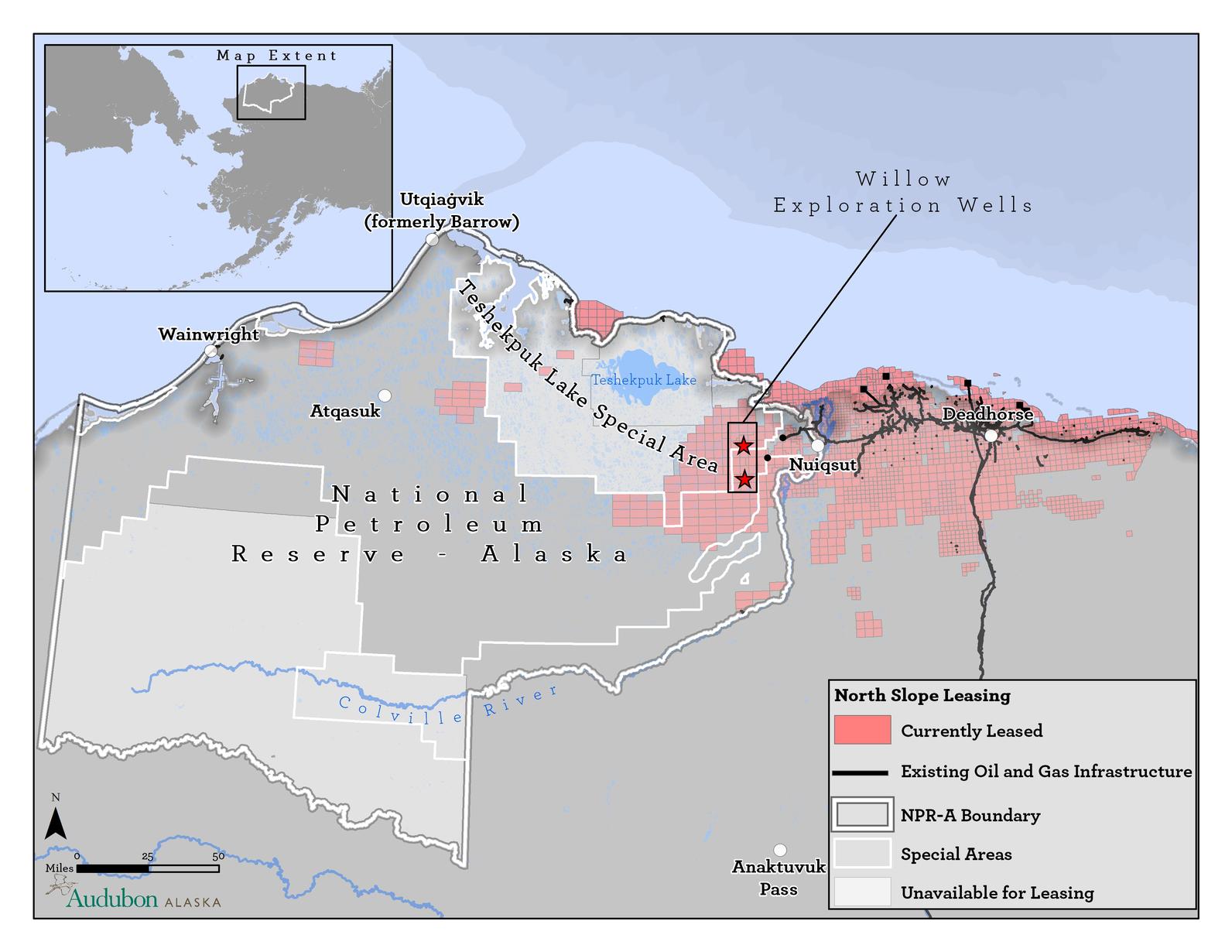
FOR IMMEDIATE RELEASE
ANCHORAGE, AK (August 7, 2018)—Today, the Bureau of Land Management’s Alaska office will announce a public scoping period to develop a “master development plan” for the Willow oil prospect on tracts leased by ConocoPhillips in Alaska’s Western Arctic. Scoping is the process used to determine the appropriate contents of an Environmental Impact Statement (EIS). The EIS, a document that describes the positive and negative effects for proposed activities on the environment, is then used in decision making. The Willow project would be located in the northeastern corner of the National Petroleum Reserve–Alaska (NPRA) near the village of Nuiqsut. And, it is just southeast of the globally-important Teshekpuk Lake wetlands complex, one of the most ecologically important habitats in the entire Arctic.
“The Willow project raises a series of scientific concerns, including impacts to migrating caribou, anadromous fish like salmon, and nesting Yellow-billed Loons, especially when we consider these issues against a backdrop of climate change and cumulative impacts,” said Ben Sullender, Spatial Ecologist for Audubon Alaska. “This project also has our close attention because it proposes a giant new footprint, with a sprawling gravel road network, near the Teshekpuk Lake wetlands complex, which contains globally significant habitat for Arctic birds and wildlife.”
The 2013 Integrated Activity Plan (IAP) governs land management decisions in the NPRA. The IAP prescribes Best Management Practices for energy development to occur in the NPRA, while also designating special areas, such as Teshekpuk Lake, where leasing and oil infrastructure are limited.
“We urge the agency to go slow, think carefully, and adhere to the Integrated Activity Plan. Using a hastened NEPA timeline for this massive development project will only gloss over the science and lead to a faulty decision,” said Susan Culliney, Policy Director for Audubon Alaska. “The complex and sensitive Arctic ecosystem deserves more consideration than can possibly be achieved through a quick and dirty fast-tracked analysis.”
The new master development plan is subject to a Trump-era Department of Interior memo that limits environmental review to one year and limits page numbers on review documents to 150 pages. Environmental review documents for a similarly situated project in 2003 consisted of over 1,500 pages of analysis and took almost two years to complete.
LINKS:
- Map of Willow and Teshekpuk Lake Special Area
- Summary of the 2017 Assessment of Wildlife Values in the Teshekpuk Wetlands Complex within the National Petroleum Reserve-Alaska (NPRA)
- Prepublication of Notice of Intent to Prepare an Environmental Impact Statement for the Willow Master Development Plan Oil and Gas Prospect, Alaska
- Order limits most NEPA studies to a year, 150 pages (E&E News, September 6, 2017)
About Audubon
Since 1977, Audubon Alaska's mission is to conserve the spectacular natural ecosystems of the state, focusing on birds, other wildlife, and their habitats, for the benefit and enjoyment of current and future generations. Audubon Alaska uses science to identify conservation priorities and support conservation actions and policies, with an emphasis on public lands and waters. Audubon Alaska is a state office of the National Audubon Society. Learn more at www.AudubonAlaska.org and @audubonalaska1.
The National Audubon Society protects birds and the places they need, today and tomorrow, throughout the Americas using science, advocacy, education and on-the-ground conservation. Audubon's state programs, nature centers, chapters and partners have an unparalleled wingspan that reaches millions of people each year to inform, inspire and unite diverse communities in conservation action. Since 1905, Audubon's vision has been a world in which people and wildlife thrive. Audubon is a nonprofit conservation organization. Learn more how to help at www.Audubon.org and follow us on Twitter and Instagram at @audubonsociety.
CONTACT:
Susan Culliney, Policy Director, sculliney@audubon.org, 907-276-7034
Rebecca Sentner, Communications Manager, rsentner@audubon.org, 907-276-7034
###



